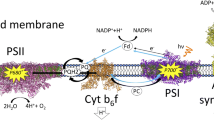Abstract
The enthalpy changes associated with each of the major steps in the photoconversion of octopus rhodopsin have been measured by direct photocalorimetry. Formation of the primary photoproduct (bathorhodopsin) involves energy uptake of about 130 kJ/mol, corresponding to storage of over 50% of the exciting photon energy, and is comparable to the energy storage previously observed in bovine rhodopsin. Subsequent intermediates involve the step-wise dissipation of this energy to give the physiological end-product (acid metarhodopsin) at a level only slightly above the parent rhodopsin. No significant differences in energetics are observed between rhodopsin in microvilli membrane suspensions or detergent dispersions. Use of different buffer systems in the calorimetric experiments shows that conversion of rhodopsin to acid metarhodopsin involves no light-induced protonation change, whereas alkali metarhodopsin photoproduction occurs with the release of one proton per molecule and an additional enthalpy increase of about 50 kJ/mol. Van't Hoff analysis of the effect of temperature on the reversible metarhodopsin equilibrium gives an enthalpy for the acid → alkali transition consistent with this calorimetric result, and the proton release is confirmed by direct observation of light-induced pH changes. Acid-base titration of metarhodopsin yields an apparent pK of 9.5 for this transition, though the pH profile deviates slightly from ideal titration behaviour. We suggest that a high energy primary photoproduct is an obligatory feature of efficient biological photodetectors, as opposed to photon energy transducers, and that the similarity at this stage between cephalopod and vertebrate rhodopsins represents either convergent evolution at the molecular level or strong conservation of a crucial functional characteristic.
Similar content being viewed by others
References
Abrahamson EW, Fager RS (1973) The chemistry of vertebrate and invertebrate visual photoreceptors. Curr Top Bioenerg 5:125–200
Ashmore JF, Falk G (1977) Dark noise in retinal bipolar cells and stability of rhodopsin in rods. Nature 270:69–71
Birge RR (1981) Photophysics of light transduction in rhodopsin and bacteriorhodopsin. Annu Rev Biophys Bioeng 10:315–354
Birge RR, Cooper TM (1983) Energy storage in the primary step of the photocycle of bacteriorhodopsin. Biophys J 42:61–69
Birge RR, Hubbard LM (1980) Molecular dynamics of cistrans isomerization in rhodopsin. J Am Chem Soc 102: 2195–2205
Boucher F, Leblanc RM (1985) Energy storage in the primary photoreaction of bovine rhodopsin. A photoacoustic study. Photochem Photobiol 41:459–465
Christensen JJ, Hansen LD, Izatt RM (1976) Handbook of proton ionization heats. John Wiley, New York
Cooper A, Converse CA (1976) Energetics of primary processes in visual excitation: photocalorimetry of rhodopsin in rod outer segment membranes. Biochemistry 15: 2970–2978
Cooper A (1979a) Energetics of rhodopsin and isorhodopsin. FEBS Lett 100:382–384
Cooper A (1979b) Energy uptake in the first step of visual excitation. Nature 282:531–533
Cooper A (1981) Rhodopsin photoenergetics: limirhodopsin and the complete energy profile. FEBS Lett 123:324–326
Cooper A (1982) Calorimetric measurements of light-induced processes. Methods Enzymol 88:667–673
Ebrey T, Tsuda M, Sassenrath G, West JL, Waddell WH (1980) Light activation of bovine rod phosphodiesterase by non-physiological visual pigments. FEBS Lett 116: 217–219
Fein A, Szuts EZ (1982) Photoreceptors: their role in vision. Cambridge University Press, Cambridge, UK
Hamdorf K (1979) The physiology of invertebrate visual pigments. In: Autrum H (ed) Handbook of sensory physiology, vol VII/6A. Springer, Berlin Heidelberg New York, pp 145–224
Henderson R (1977) The purple membrane from Halobacterium halobium. Annu Rev Biophys Bioeng 6:87–109
Hubbard R, Bownds D, Yoshizawa T (1965) The chemistry of visual photoreception. Cold Spring Harbour Symp Quant Biol 30:301–315
Kitagawa T, Tsuda M (1980) Resonance Raman spectra of octopus acid and alkaline metarhodopsins. Biochim Biophys Acta 624:211–217
Knowles A, Dartnall HJA (1977) The eye, vol 2B. 2nd edn. Academic Press, New York
Kusumi A, Tsuda M, Akino T, Ohnishi S, Terayama Y (1983) Protein-phospholipid-cholesterol interaction in the photolysis of invertebrate rhodopsin. Biochemistry 22:1165–1170
Matthews RG, Hubbard R, Brown PK, Wald G (1963) Tautomeric forms of metarhodopsin. J Gen Physiol 47:215–240
O'Tousa JE, Baehr W, Martin RL, Hirsh J, Pak WL, Applebury ML (1985) The Drosophila ninaE gene encodes an opsin. Cell 40:839–850
Ovchinnikov YA (1982) Rhodopsin and bacteriorhodopsin: structure—function relationships. FEBS Lett 148:179–189
Ovchinnikov YA, Abdulaev NG, Feigina NY, Artamonov ID, Zolotarev AS, Miroshnikov AI, Martynov UI, Kustina MB, Kudelin AB, Bogachuk AS (1982) The complete amino acid sequence of visual rhodopsin. Bioorg Khim 8: 1011–1014
Packard A (1966) Operational convergence between cephalopods and fish: an exercise in functional anatomy. Arch Zool Ital 51:523–542
Packard A (1972) Cephalopods and fish: the limits of convergence. Biol Rev 47:241–307
Parkes JH, Liebman PA (1984) Temperature and pH dependence of the metarhodopsin I — metarhodopsin II kinetics and equilibria in bovine rod disk membrane suspensions. Biochemistry 23:5054–5061
Saibil HR, Michel-Villaz M (1984) Squid rhodopsin and GTP-binding protein crossreact with vertebrate photoreceptor enzymes. Proc Natl Acad Sci USA 81:5111–5115
Stoeckenius W (1980) Purple membrane of halobacteria: a new light-energy converter. Acc Chem Res 13:337–344
Tsuda M (1979) Transient spectra of intermediates in the photolytic sequence of octopus rhodopsin. Biochim Biophys Acta 545:537–546
Tsuda M, Tokunaga F, Ebrey T, Yue KT, Marque J, Eisenstein L (1980) Behaviour of octopus rhodopsin and its photoproducts at very low temperature. Nature 287:461–462
Tsuda M, Terayama Y, Takahashi M (1982) Absorption spectra and molar extinction coefficients of octopus rhodopsin and its photoproducts. Jinbun Shizen Kagaku Kiyo 23:37–41
Warshel A, Barboy N (1982) Energy storage and reaction pathways in the first step of the vision process. J Am Chem Soc 104:1469–1476
Wells MJ (1983) Caphalopods do it differently. New Sci 100: 332–338
Zuker CS, Cowman AF, Rubin GM (1985) Isolation and structure of a rhodopsin gene from D. melanogaster. Cell 40:851–858
Author information
Authors and Affiliations
Rights and permissions
About this article
Cite this article
Cooper, A., Dixon, S.F. & Tsuda, M. Photoenergetics of octopus rhodopsin. Eur Biophys J 13, 195–201 (1986). https://doi.org/10.1007/BF00260367
Received:
Accepted:
Published:
Issue Date:
DOI: https://doi.org/10.1007/BF00260367




